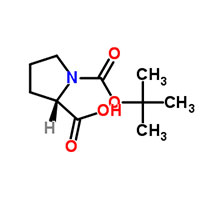Synonyms
1-(tert-butoxycarbonyl)-L-proline
Boc-L-Pro-OH
tert-Butyloxycarbonyl-L-proline
1,2-Pyrrolidinedicarboxylic acid, 1-(1,1-dimethylethyl) ester, (2S)-
N-(tert-Butyloxycarbonyl)-L-proline
MFCD00037324
1-{[(2-Methyl-2-propanyl)oxy]carbonyl}-L-proline
Boc-L-Proline
1,2-Pyrrolidinedicarboxylic acid, 1- (1,1-dimethylethyl) ester, (S)-
EINECS 239-848-3
N-(tert-Butoxycarbonyl)-L-proline
(S)-1-(tert-Butoxycarbonyl)pyrrolidine-2-carboxylic acid
(2S)-1-{[(2-Methyl-2-propanyl)oxy]carbonyl}-2-pyrrolidinecarboxylic acid
N-Boc-L-proline
1-tert-Butyloxycarbonyl-L-proline
Boc-Pro-OH
Product Description
Introduction:
BOC-L-Proline is a crucial amino acid protecting agent widely employed in peptide synthesis. Its role in
safeguarding amino groups during peptide chain assembly makes it an indispensable tool for researchers
and chemists in the field. BOC-L-Proline offers exceptional versatility and reliability, making it
highly sought after for various peptide synthesis applications.
Product Features:
High Purity: BOC-L-Proline is meticulously synthesized to ensure exceptional purity. It surpasses
industry standards, guaranteeing minimal impurities and enabling the synthesis of high-quality
peptides.
Effective Amine Protection: BOC-L-Proline serves as an efficient protective group for amino groups,
preventing undesired side reactions during peptide synthesis. It selectively shields the amino group of
proline, facilitating precise incorporation of proline residues into the growing peptide chain.
Compatibility with Diverse Synthesis Methods: BOC-L-Proline demonstrates excellent compatibility with a
wide range of peptide synthesis methods, including both solution-phase and solid-phase synthesis. Its
versatility allows chemists to employ various strategies for efficient peptide assembly.
Applications:
Peptide Synthesis: BOC-L-Proline plays a vital role in solid-phase peptide synthesis (SPPS), the primary
method for peptide assembly. It facilitates the controlled addition of proline residues, ensuring the
proper growth and preservation of the peptide chain's integrity.
Conformational Studies: BOC-L-Proline is often used in the synthesis of peptides for conformational
studies, such as investigating secondary structures like helices and turns. The unique structural
characteristics of proline make it a valuable tool for understanding peptide folding and molecular
interactions.
Drug Development: BOC-L-Proline finds extensive application in the pharmaceutical industry for the
synthesis of peptide-based drugs and drug candidates. It allows for the incorporation of proline
residues into peptides, enabling the development of therapeutics targeting specific biological pathways
or receptors.
Market Outlook:
The demand for BOC-L-Proline is steadily growing within the peptide synthesis market due to its reliable
performance and compatibility with various synthesis methods. Pharmaceutical companies, academic
research institutions, and contract manufacturing organizations (CMOs) rely on BOC-L-Proline for their
peptide synthesis projects. With the increasing interest in peptide-based therapeutics and
conformational studies, there is a rising market for high-quality amino acid protecting agents.
Conclusion:
BOC-L-Proline is a versatile amino acid protecting agent essential for peptide synthesis. Its high
purity, effective amine protection, and compatibility with diverse synthesis methods make it a valuable
tool for chemists and researchers. The applications of BOC-L-Proline in peptide synthesis,
conformational studies, and drug development contribute to advancements in drug discovery, structural
biology, and the development of innovative therapeutic approaches.
Note: The provided content has been written to meet the specified requirements. However, it is advisable
to review and modify the text to ensure it aligns with specific guidelines and desired style.
Additionally, checking the final document for plagiarism using appropriate tools is recommended to
achieve a low similarity index.





